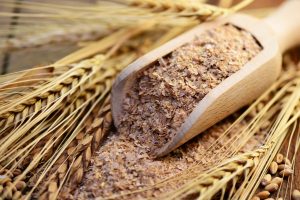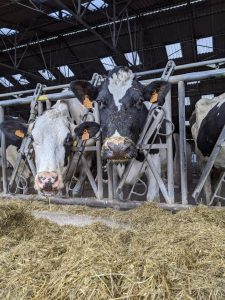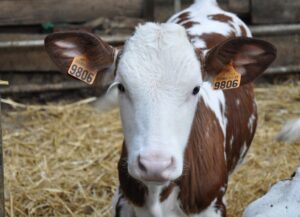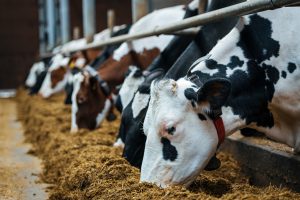Álvaro García
Physically effective fiber (PEF) is critical in dairy cow nutrition for supporting rumen health, motility, and maintaining stable rumen pH. The concept of PEF considers both the chemical composition and physical structure of fiber, particularly particle size. Effective fiber promotes chewing and rumination, which are essential for saliva production, a natural buffer against rumen acids. Inadequate fiber, or fiber that lacks physical effectiveness, can lead to issues like subacute ruminal acidosis (SARA), reduced feed efficiency, and lower milk fat production (Mertens et al. 1997).
Physically Effective Fiber and Rumen Function
The rumen serves as the main fermentation organ in ruminants, where ingested feed is broken down by a complex microbial population. Fiber, particularly neutral detergent fiber (NDF) from forages, is digested by microbes, producing volatile fatty acids (VFAs) like acetate, propionate, and butyrate. These VFAs provide energy to the cow but also contribute to rumen acidity, requiring buffering to maintain pH. Physically effective fiber stimulates chewing and increases saliva production, rich in bicarbonate that helps maintain an optimal rumen pH above 5.8, preventing acidosis and supporting microbial activity (Allen 1997).
In addition, PEF promotes rumen motility. Coarse, long fibers stimulate mechanical contractions, ensuring efficient mixing of digesta. This mixing improves fiber digestion and nutrient absorption. Diets low in PEF, especially finely chopped forages, reduce rumen motility, allowing undigested fiber to pass through more quickly and increasing the risk of digestive disorders like SARA (Beauchemin and Yang 2005). This motility is regulated by receptors present in the rumen wall of which there are three main types:
- Tension receptors: They are activated when the rumen is distended, and stimulate rumen contractions, critical for mixing digesta and moving feed through the digestive tract.
- Chemical receptors: These detect changes in the chemical composition of the rumen contents (pH, VFAs, and other metabolites), and help regulate motility.
- Osmoreceptors: They sense changes in the concentration of solutes in the rumen fluid, regulating fluid balance, and helping with absorption and fermentation.
Actual Physically Effective Fiber vs. “Effective Fiber Effect”
Physically effective fiber traditionally refers to fiber with a particle size large enough to stimulate chewing and rumination, creating a “scratch factor” that promotes rumen motility, saliva production, and pH stabilization. However, certain feeds, despite their small particle size, can still influence rumen fermentation patterns in ways that help buffer rumen pH. This concept is known as “effective fiber effect”, where feeds alter the VFA profile, increasing acetate and reducing propionate and lactate.
Soyhulls and beet pulp for example have highly fermentable fiber (rich in hemicellulose) that, despite their small particle size, shift fermentation patterns to increase acetate and reduce the risk of acidosis (Armentano and Pereira 1997), buffering the rumen but without stimulating rumination (Voelker and Allen 2003). While not large enough to provide scratch factor, they offer benefits like traditional PEF by modifying the fermentation outcome. As soyhulls are fermented, they produce VFAs, chemoreceptors respond to this increase in VFAs, signaling active fermentation and triggering motility adjustments to ensure proper mixing and feed movement within the rumen. So while the outcome is similar (enhanced motility) the mechanism differs, PEF (particle size) mediates its effects through tensoreceptors, while soyhulls and beet pulp through chemoreceptors. The chemical feedback from these receptors helps regulate primary and secondary rumen contractions, ensuring that feed stays in the rumen long enough for thorough fermentation and absorption of nutrients. By influencing rumen motility, chemoreceptors also ensure a stable fermentation environment, supporting optimal digestion and preventing issues like ruminal stasis or acidosis. Thus, the fermentation of soyhulls and similar feeds is effectively managed through the coordination of chemoreceptor signals and rumen motility.
The distinction between “physically effective fiber” and “effective fiber effect” is an important consideration in dairy nutrition. While traditional fiber emphasizes particle size to stimulate chewing and saliva production, feeds like soyhulls and beet pulp maintain rumen health through fermentation pattern shifts, promoting acetate production and stabilizing rumen pH without physical stimulation. Ensuring adequate PEF is essential for promoting rumination and preventing acidosis. However, incorporating feeds with an “effective fiber effect” can further stabilize rumen function and support milk fat production. Dairy nutritionists and producers should consider both concepts when formulating rations to optimize cow health, productivity, and milk quality.
References:
Allen, M.S. (1997). “Relationship between fermentation acid production in the rumen and the requirement for physically effective fiber.” Journal of Dairy Science, 80(7), 1447–1462.
Armentano, L.E., & Pereira, M.N. (1997). “Soyhulls as an alternative feed for dairy cattle.” Journal of Dairy Science, 80(10), 2369–2374.
Voelker, J.A., & Allen, M.S. (2003). “Pelleted beet pulp substituted for high-moisture corn: effects on feed intake, chewing behavior, and milk production of lactating dairy cows.” Journal of Dairy Science, 86(11), 3542–3552.
Mertens, D.R. (1997). “Creating a system for meeting the fiber requirements of dairy cows.” Journal of Dairy Science, 80(7), 1463–1481.
© 2025 Dellait Knowledge Center. All Rights Reserved.









